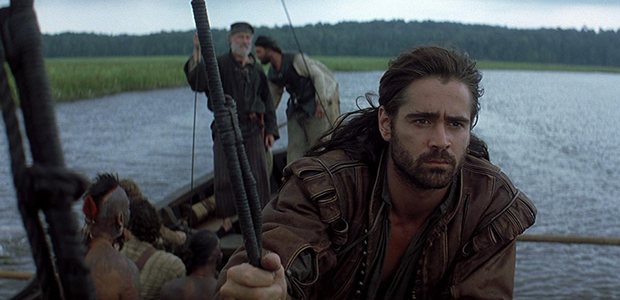
Amongst astute film lovers, a Terrence Malick film ignites about the same amount of interest as a rare solar eclipse. Widely hailed as the J. D. Salinger of the American film world (and rightly so), this reclusive, visual genius has concocted some of the most mythic and resonant films about love and death with a mastery for framing indelible, precise images where landscapes, never people, dominate the screen. By those accounts, The New World is at once both a quintessential Malick film and a rare cinematic episode. It is as unique an experience as his The Thin Red Line or even the serene, Days of Heaven and probably just as memorable as the two in how it is both a war film and a sublime story of love.
The canvas upon which Malick weaves his tapestry of fluid imagery is 1607 Virginia. This is where the myth of Pocahontas (Q’orianka Kilcher) is set; where she saves the life of Captain John Smith (Colin Farrell) when he is captured and brought to her tribe, and then slowly becomes smitten by him; where she also faces the passionate desires of John Rolfe (Christian Bale), the man with whom she spends the remainder of her days. But most of all, this picturesque setting presents Malick with the opportunity to play to his strengths as a director eternally infatuated with the search for Eden on Earth, and then offering us its inevitable destruction. All of this is expertly weaved into the abstract, elliptical narrative which finds a British fleet lead by Captain Newport (Christopher Plummer) invading native Indian settlers, trying to befriend them, failing and ultimately battling them. What follows, as the title of the film promises, is that we bare witness to two discoveries, one of the titular new world, and the other where Pocahontas visits England.
But in a film such as this, screenplay, structure and filmic expectations take a back seat. Take into account one of the best moments of The New World, when Pocahontas (never referred to by name), submits in to her true feelings for Smith and, in a familiar and recurring motif used by the director in all his films, conveys to us her feelings via the use of voiceover as an internal monologue laced with conflict while the Wagner score swells and swells and swells till we are overwhelmed by what we see. This scene perfectly embodies the symphonic blend of the visual and aural richness of what best Malick represents. But he chooses to show us, at these intense moments, the rarest of rare natural occurrences – a lightening strike in the background during darkness as a person looks seaward, an indescribable flight pattern formed by a flock of birds. To him, bringing to screen the ethereal, dreamlike beauty of the Earthly world around us is the best form of enriching our experiences as living individuals and elevating our film viewing sensation, but this even serves as a metaphor of the characters sensory awakening. Just the way a smart twist in a script or an intense character development in a drama would make us wonder in awe in a conventional film, in a Malick film the deep focus photography and the juxtaposing of these with the story unfolding onscreen, sometimes even at tangents to each other, should be enough to make us feel a sensation akin to shortness of breath in our appreciation of it.
And what of performances? And plot development? They exist in strong amounts but are not the highlights, as they have never been, because the director always chooses to keep them in the backdrop but also because his characters are full of existentialism that is too subjective to be questioned or criticized. Though this has never bothered me, those in for a nascent encounter may feel agitated, even scornful of such a method, for it yields little of conventional value. To be nitpicky of these factors is to miss the essence of why such painterly strokes are made with a poet’s yearning.
Of all the maverick film directors from the 70’s, only Terrence Malick remains the one true passionate artist. Perhaps his distancing of himself from his brethren has allowed him such luxury. In any case, The New World must be seen because it is the work of a director who refuses to abandon his struggle of bringing his sweeping vision for people to see. At times I felt he was trying, with his latest attempt, to reach out for more mainstream acceptability (casting Farrell and Bale for e.g.), but if a viewing of The New World is any indication, he is nowhere close to accomplishing it. For this I am in some selfish way, glad and grateful, because it allows the scant few of us who have cherished his body of work to continue to do so and eagerly anticipate what more there is to come (if any at all). I fear we will not see another Malick film till at least the end of this decade, but till then we have his latest to savour.
Rating: 



